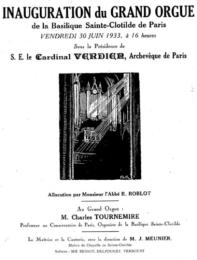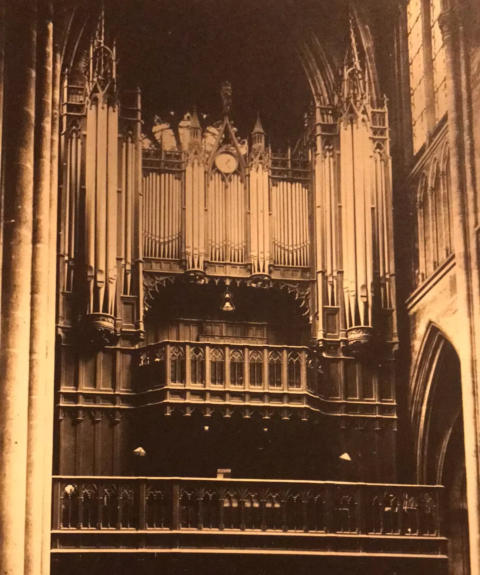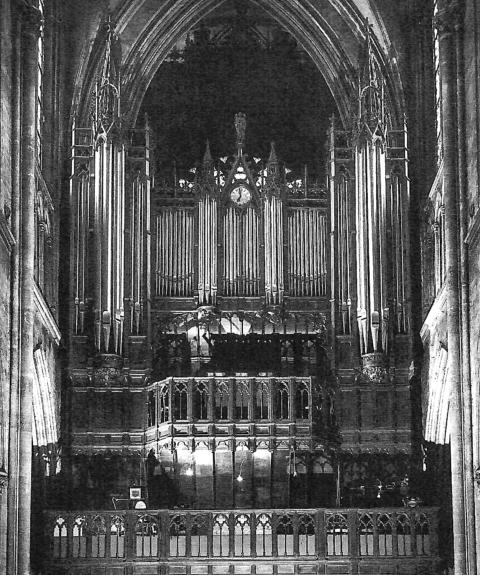COMPOSITION 1933
THE ENLARGMENT OF THE ORGAN
A first, substantial, change of the instrument of Cavaillé-Coll was realized in 1933 under the direction of the titulaire, Charles Tournemire, both in terms of stops and reharmonisation and in terms of mechanics. The works were carried out by Joseph Beuchet-(Ets Cavaillé-Coll).THE REASONS
In a letter to Carl Weinrich, Charles
Tournemire complained about the
precarious state of the organ: "The organ of
Sainte Clotilde is in such poor condition
that it has been decided to repair it." In
addition to its multiple failures due to its
great age (seventy-two years without
restoration), the instrument presented to
Tournemire some technical weaknesses:
•
The range of keyboards and pedals: 54
notes (C, f3) for keyboards and 27 notes
(C, d1) for pedals.
•
The high number of 8-foot foundations
and the lack of mutations
•
The relative poverty of stops on the
Swell which had, moreover, no mixtures
and mutations
•
The Pedal, which had a limited number
of foundation stops.
Although consistent with the aesthetics of
the young Cavaillé-Coll of 1859, the
composition was no longer up-to-date in
1930. Tournemire was one of the first to
rediscover the early European music,
especially in Frescobaldi, Buxtehude,
Cabanilles, Pachelbel, Grigny and Bach.
Therefore, it does not appear unthinkable
that, taking advantage of the instrument's
dilapidation, Tournemire wanted more
than a 'pious' restoration and favored the
implementation of his innovative ideas
with respect to the organ building. He
elaborated on these ideas in the a notice of
the inauguration of 1933:
This enrichment is justified by the concern
that I had, in conscience, to fully serve the
Art of the Organ, from the 13th century to
the present day. In addition, I have not
forbade myself to think about future
possibilities ...
EYEWITNESS REPORTS
Following the inauguration of the organ modified
by the Maison Beuchet, many personalities from
the Parisian organ world spoke about the work
done.
• Tournemire • Miramon Fitz-James/André Fleury • Pierre Moreau • Maurice Emmanuel Some articles published in journals Revue des Amis de l’orgue septembre 1939THE ORGAN OF CHARLES TOURNEMIRE
The works included:
•
Conservation of the original traction, including the two Barker machines
•
Installation of a pneumatic stoptraction
•
Extension of the manuals to 61 notes (C-c4), and the pedal to 32 notes (C-
g1), requiring the placement of supplementary windchests for Great, Pos
and Swell; the extension of the pedal was realized within the existing
windchest
•
Enlargement and deepening of the Swell by adding a new windchest (with
six stops) behind the original and porbably the installation of a Barker
machine for the swell
•
A lowering of wind pressure of the Positive. According to Marie-Louise
Langlais (source: video), Tournemire wanted to achieve a significant
difference between the GO and the positive (which was originally louder
than GO). The result was a change in the balance between the GO and the
Positif compared with the organ known by Franck and Tournemire (before
1933).
•
Installing of a new ergonomic console with several new features, including
26 spoons of combinations. The expression pedal was refocused. The layout
of the stops was as follows: the sets of funds on the left, the sets of
combinations on the right, like the combination pedals.
Aware of the historical value of Franck's console, Tournemire bought it
from the parish priest of Sainte-Clotilde and his widow gave it to his former
friend Flor Peeters (Belgium). In turn, Flor Peeters gave it by will to the
Royal Conservatory of Antwerp. It is now showed at the Vleeshuismuseum
in Antwerp.
The composition was also modified (an addition of about 40% to the
original piping). The changes and additions were:
Great
•
+ cornet V (on a small additional windchest);
•
Octave 4' replaced by a Flûte 4' (perhaps realized during the 1962-
works)
Positive
•
+ Tierce 1 3/5' + Piccolo 1' (on the place of the Clarinette which had been
moved to the Swell);
•
the Unda maris was tuned equally and called Salicional;
•
the Flûte octaviante 4' was transformed into a Flûte 4'.
•
the Viole de Gambe was reharmonized
Récit
•
+ Quintaton 16' + Nasard 2 2/3' + Tierce 1 3/5' + Plein Jeu IV + Bombarde
16' + Clarinette 8' (of the Positif)
•
Addition of the first octave octave of the Gambe 8’
Pedal
•
Addition of a Soubasse 16 and a Quinte 5 1/3 on an additional new
windchest in front of the Swell. This addition caused an imbalance
between the Swell and the Positive. That's why (probably just after
1945), a part of the roof of the organ case was taken away and replaced
by a sound board placed approx. 1 meter above the case to improve to
sound of the Swell in the church.
•
Basse 8' was transformed into a Flûte 8’
•
Octave 4' was transformed into a Flûte 4'.
The works started in July 1932. The reharmonisation
was done by Michel Merz and the mechanical works
(restoration and enlargement) were carried out by
Berthelot and Thiemann. The costs were
approximately 250,000 franc. The inspection took
place on June 27, 1933, in the presence of Albert Alain,
Joseph Bonnet, Paul Brunold, Alexandre Cellier, André
Marchal, Dom Letestu (organist at Solesmes) and Félix
Raugel. The inauguration was on Friday 30 June in the
presence of Cardinal Verdier, Archbishop of Paris. The
program of Tournemire: Tiento VII of Cabanilles,
Buxtehude's Toccata (BuxWV 156), the third Chorale by
Franck, a first performance of the first two of his three
poems opus 59, Communion of the sunday in the octave of the Ascension of
the ‘Orgue Mystique’ and an improvisation.
* The last audition of the organ "of Franck" was given by seven students of Tournemire, on April 25, 1932 (Daniel Lesur, Gaston Litaize, Jean Langlais, Olivier Messiaen, Noelie Pierront,
Maurice Duruflé and André Fleury). The program was devoted to the compositions of "L’orgue mystique.
.** The harmonist Michel Mertz was trained in the Cavaillé-Coll workshop, where he entered in May 1898 (National Library of France, RES VMA MS-1370), the same year that Aristide
Cavaillé-Coll sold his business to Charles Mutin. According to Jean-Marc Cicchéro (Hommage à une passion, p. 68), he remained there until 1936. But he was not part of the staff of the
Beuchet-Debierre house.


THE GREAT ORGAN 3/5
the organ of Franck - the organ of Tournemire - the organ of Langlais - the organ of Taddei
RECORDINGS
César Franck
Prière en ut dièse mineur
Fantaisie en La Majeur
Final
Feike Asma, Sainte Clotilde, 1959
Source

A photo of the Grand Orgue taken by Maurice Duruflé
himself (with thanks to Frédéric Blanc)

Another photo of the Great Organ in the era of Tournemire
THE GREAT ORGAN
3/5
the organ of Franck - the organ of
Tournemire - the organ of Langlais -
the organ of Taddei
THE ORGAN OF CHARLES TOURNEMIRE
THE ENLARGMENT OF THE ORGAN
A first, substantial, change of the instrument of Cavaillé-Coll was realized in 1933 under the direction of the titulaire, Charles Tournemire, both in terms of stops and reharmonisation and in terms of mechanics. The works were carried out by Joseph Beuchet-(Ets Cavaillé- Coll).
The works included:
•
Conservation of the original traction,
including the two Barker machines
•
Installation of a pneumatic stoptraction
•
Extension of the manuals to 61 notes (C-
c4), and the pedal to 32 notes (C-g1),
requiring the placement of supplementary
windchests for Great, Pos and Swell; the
extension of the pedal was realized within
the existing windchest
•
Enlargement and deepening of the Swell
by adding a new windchest (with six stops)
behind the original and porbably the
installation of a Barker machine for the
swell
•
A lowering of wind pressure of the Positive.
According to Marie-Louise Langlais
(source: video), Tournemire wanted to
achieve a significant difference between
the GO and the positive (which was
originally louder than GO). The result was a
change in the balance between the GO
and the Positif compared with the organ
known by Franck and Tournemire (before
1933).
•
Installing of a new ergonomic console with
several new features, including 26 spoons
of combinations. The expression pedal was
refocused. The layout of the stops was as
follows: the sets of funds on the left, the
sets of combinations on the right, like the
combination pedals.
Aware of the historical value of Franck's
console, Tournemire bought it from the
parish priest of Sainte-Clotilde and his
widow gave it to his former friend Flor
Peeters (Belgium). In turn, Flor Peeters
gave it by will to the Royal Conservatory of
Antwerp. It is now showed at the
Vleeshuismuseum in Antwerp.
The works started in July 1932. The
reharmonisation was done by Michel Merz and
the mechanical works (restoration and
enlargement) were carried out by Berthelot
and Thiemann. The costs were approximately
250,000 franc. The inspection took place on
June 27, 1933, in the presence of Albert Alain,
Joseph Bonnet, Paul Brunold, Alexandre
Cellier, André Marchal, Dom Letestu (organist
at Solesmes) and Félix Raugel. The
inauguration was on Friday 30 June in the
presence of Cardinal Verdier, Archbishop of
Paris. The program of Tournemire: Tiento VII of
Cabanilles, Buxtehude's Toccata (BuxWV 156),
the third Chorale by Franck, a first
performance of the first two of his three
poems opus 59, Communion of the sunday in
the octave of the Ascension of the ‘Orgue
Mystique’ and an improvisation.
The composition was also modified (an
addition of about 40% to the original piping).
The changes and additions were:
Great
•
+ cornet V (on a small additional
windchest);
•
Octave 4' replaced by a Flûte 4' (perhaps
realized during the 1962-works)
Positive
•
+ Tierce 1 3/5' + Piccolo 1' (on the place of
the Clarinette which had been moved to
the Swell);
•
the Unda maris was tuned equally and
called Salicional;
•
the Flûte octaviante 4' was transformed
into a Flûte 4'.
•
the Viole de Gambe was reharmonized
Récit
•
+ Quintaton 16' + Nasard 2 2/3' + Tierce 1 3/5'
+ Plein Jeu IV + Bombarde 16' + Clarinette 8'
(of the Positif)
•
Addition of the first octave octave of the
Gambe 8’
Pedal
•
Addition of a Soubasse 16 and a Quinte 5 1/3
on an additional new windchest in front of
the Swell. This addition caused an
imbalance between the Swell and the
Positive. That's why (probably just after
1945), a part of the roof of the organ case
was taken away and replaced by a sound
board placed approx. 1 meter above the
case to improve to sound of the Swell in
the church.
•
Basse 8' was transformed into a Flûte 8’
•
Octave 4' was transformed into a Flûte 4'.
EYE WITNESS REPORTS
Following the inauguration of the organ
modified by the Maison Beuchet, many
personalities from the Parisian organ
world spoke about the work done.
•
Tournemire
•
Miramon Fitz-James/André Fleury
•
Pierre Moreau
•
Maurice Emmanuel
More information on the desktop version of
this site.














